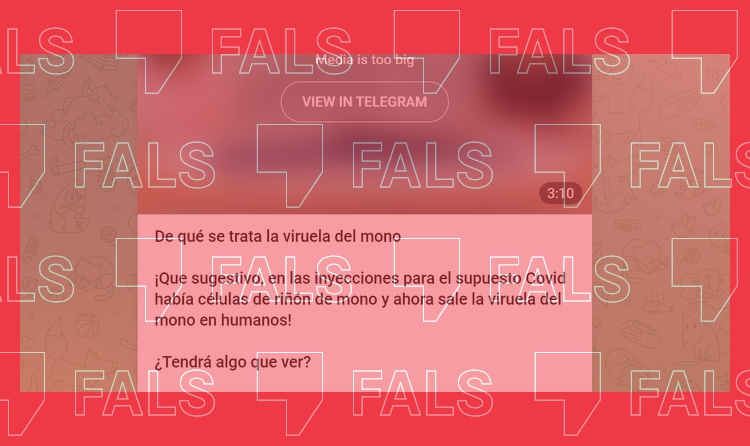Monkeypox was not caused by the covid-19 vaccine

You’ve sent us messages that make a variety of claims about the origins of monkeypox, …

You’ve sent us messages that make a variety of claims about the origins of monkeypox, such as that it was caused by the Covid vaccine. These claims are FALSE.
None of the vaccine package inserts of any of the vaccines marketed in Europe list monkey kidney cells in their ingredients. The only link that has been found between the two things – which could not possibly be the origin of monkeypox – is in the CoronaVac vaccine. In the production process of this drug, monkey kidney cells were used to grow the viruses that were later inactivated and constituted the main component of the vaccine developed by SinoVac. However, those viruses were SARS-CoV-2 and, therefore, had zero connection with monkeypox.
There were monkey kidney cells in the vaccines against the alleged Covid and now monkeypox is showing up in humans.
Monkeypox is a viral zoonosis —a virus transmitted to humans by animals-– with symptoms similar to smallpox, although it is clinically less severe, as the World Health Organization (WHO) explains. Nature magazine explains that the illness was given its name because researchers detected the virus for the first time in lab monkeys in 1958; but that the name could, in reality, be misleading because, as the scientific community explains, the virus was transmitted to humans either by wild animals, such as African rodents, or via contaminated materials. More than 60 years later, the natural history of the virus is still not clear.
Where does the link with monkey cells come from?
The vaccine developed by SinoVac, also known as CoronaVac, is a covid-19 vaccine validated by the WHO and distributed in 56 different countries, although it was not authorised in Europe. This vaccine was made by adding SARS-CoV-2 to a lineage of cells known as Vero cells, which comes from monkey kidney cells, according to an article published in The Lancet about the safety, tolerability and immunogenicity of CoronaVac. This could be the origin of the misleading claims spreading on social media, which state that the vaccine contained monkey cells.
The article in The Lancet adds that after the incubation period was over, the virus was harvested and inactivated so it could not be infectious once inoculated into humans via the vaccine. Therefore, neither the virus – in this case, SARS-CoV-2 – nor the use of monkey cells, which were only used as a means to get the virus to reproduce, could be the origin of monkeypox.
AstraZeneca and the chimpanzees
Viral vector vaccines, such as the one by AstraZeneca, store genetic information in a carrier with instructions to produce the virus protein that the immune system will learn to fight (in the case of SARS-CoV-2, the spike protein). This carrier, which we have written about before (Catalan only) and which is known as a vector, is a weakened, non-replicating version of a virus different from the one targeted by the vaccine.
The formula of the AstraZeneca vaccine is made with an adenovirus that usually causes a common cold in chimpanzees, according to the Vaccine Advisory Committee of the Spanish Association of Paediatrics (Spanish only). The vaccine does not under any circumstances contain monkey cells, as claimed by the viral statements.
In order to use it as a viral vector in the AstraZeneca vaccine, i.e. to show it how to carry the information from the vaccine into the cells, this virus has been genetically modified, thereby making it impossible for it to grow and develop its life cycle in humans.
These types of vectors have been widely studied since their discovery in 1972, and the conclusion is that they can be used safely. On the other hand, the vector used to make the AstraZeneca vaccine is from a different family than the one that produces monkeypox. The former is the Adenoviridae family, which causes the common cold, while the monkeypox vector comes from the Poxviridae family. We can find more information about these two different virus families in a document published by the University of Las Palmas de Gran Canaria (Spanish only).